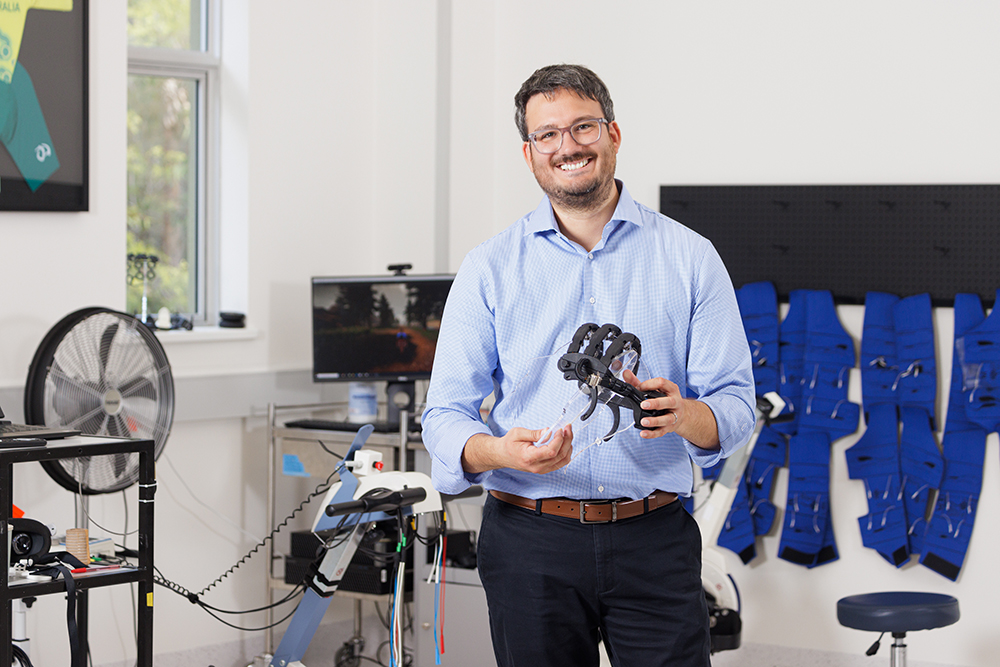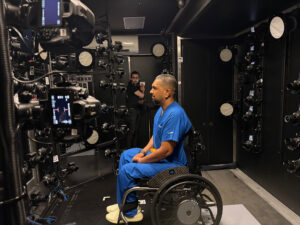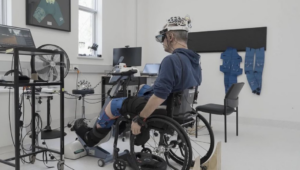
Griffith University’s BioSpine team, led by Dr Claudio Pizzolato, has won a coveted place in a health tech accelerator program that drives commercialisation of start-up technologies in the Gold Coast Health and Knowledge Precinct (GCHKP).
Dr Pizzolato will join the intensive 14-week LuminaX (LX) program, together with BioSpine Coordinator Kyle Mullholland and with support from co-investigator Dr Dinesh Palipana OAM, Griffith’s commercialisation office, Griffith Enterprise, and an almost 30-strong multi-disciplinary GCORE research team, who continue to advance the novel rehabilitation technology through a second round of clinical studies.
LuminaX helps validate and commercialise early-stage, high-growth activities applying tech or AI solutions to healthcare, medtech and wellness, and draws start-ups from around Australia through a competitive application process.

BioSpine is a digitally-enabled rehabilitation system for spinal cord injury (SCI) that brings together non-invasive technologies – assistive exercise devices, electrical stimulation, a brain computer interface that uses AI to help interpret a participant’s intention to move and virtual reality to create an immersive rehab environment, all controlled through an advanced digital twin.
Through coordinating this powerful combination of technologies, BioSpine seeks to harness neuroplasticity to stimulate residual neurons in paralysed individuals and restore sensory and motor function.
As research and clinical studies progress, Dr Pizzolato is eager to take a parallel focus on the pathway to translating BioSpine into the clinic through commercial investment.
“We are extremely excited to have been selected for LuminaX,” Dr Pizzolato said.
“It’s a fantastic opportunity to fast-track the translation of our BioSpine technology for every person that might benefit from it.
We look forward to building our network by getting to know all the LuminaX mentors and learning how to pitch for investment and scale globally.
Our team is backed by Griffith Enterprise (the University’s commercialisation arm), a demonstration of the commitment of Griffith to making an impact.”

Last year BioSpine was boosted with a $3.8m grant from the Queensland Motor Accident Insurance Commission (MAIC), following initial MAIC funding of over $2.2m in 2019. The grant supports expansion of the protocol to include direct electrical stimulation of the spine, as well as expanded clinical studies across a larger cohort of participants and continued co-development and design with the goal of making BioSpine clinic-ready.
Director of Griffith Enterprise Dr Mark Ashton said that while BioSpine is complex ‘deep tech’, there are a number of different commercial opportunities.
“Bringing BioSpine into widespread clinical practice in a global market is a massive undertaking, however Griffith Enterprise is working closely with the research team to protect intellectual property and seek commercial partners for the technology,” Dr Ashton said.
“The additional support from the LuminaX program and mentors, access to venture capital networks and the peer support of being part of an entrepreneurial program are really invaluable for the team and our commercialisation efforts.
We are excitted to support the BioSpine team through the process.”
Now in its fourth year, the LX program, delivered by Cohort, is supported by Major Partners: Economic Development Queensland, the City of Gold Coast, and Queensland Investment Corporation (QIC), alongside Griffith University, Mater Hospital, QLD AI Hub, and IntelliHQ.
Backed by the Queensland Venture Capital Development Fund (VCDF) program, participants will have a unique opportunity to connect with some of the largest VC funds and investors in Australia.
Griffith University’s Vice President of Industry and External Engagement, Professor Bronwyn Harch, said having a successful health tech accelerator in the GCHKP gave researchers easy access to a sophisticated and powerful innovation ecosystem.
“Last year we had two teams from Griffith University participate in LuminaX, both focused on technologies that benefit children,” Professor Harch said.
“One team. AlignUs, is successfully commercialising surgeries for children with complex hip deformities, supported by Griffith’s Advanced Design and Prototyping Technologies Institute (ADaPT), while the team behind YourTrack, which actually won the LuminaX 2023 top award, is rolling out neurodevelopmental assessment tools to help children in remote, Indigenous and disadvantaged communities, and has since secured $6.5m in additional government funding.”
“These outcomes demonstrate the importance of gaining industry knowledge and connections through innovation programs, and as a leading research initiative, BioSpine has great scope to significantly extend Griffith’s impact globally.”
Approximately 20,800 Australians are living with SCI, with 350-400 people sustaining a new injury each year. BioSpine also has potential to help individuals suffering other types of neurotrauma.




